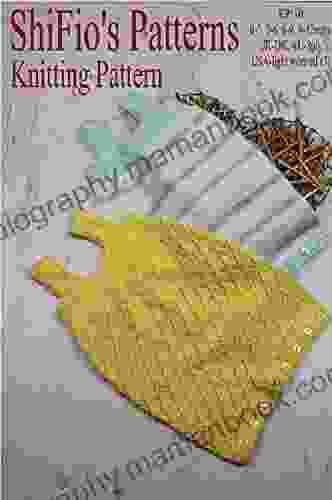Handbook of Fibre Rope Technology: The Definitive Guide to Natural and Synthetic Fibres for Rope Making

Rope is an essential tool in a wide variety of industries, from shipping and construction to sports and recreation. The type of rope used for a particular application will depend on a number of factors, including the strength, durability, and flexibility required.
5 out of 5
| Language | : | English |
| File size | : | 32074 KB |
| Text-to-Speech | : | Enabled |
| Screen Reader | : | Supported |
| Enhanced typesetting | : | Enabled |
| Print length | : | 432 pages |
In recent years, there have been significant advances in fibre rope technology, with the development of new materials and manufacturing processes. These advances have resulted in the production of ropes that are stronger, more durable, and more flexible than ever before.
The Handbook of Fibre Rope Technology is the definitive guide to the latest developments in this field. This comprehensive handbook provides a thorough understanding of the different types of fibres used in rope making, the manufacturing processes involved, and the properties and applications of different types of ropes.
Natural Fibres
Natural fibres have been used to make rope for centuries. The most common natural fibres used in rope making include:
- Cotton: Cotton is a soft, strong fibre that is resistant to abrasion and mildew.
- Linen: Linen is a strong, durable fibre that is also resistant to rot and mildew.
- Hemp: Hemp is a strong, durable fibre that is also resistant to water and UV radiation.
- Sisal: Sisal is a strong, stiff fibre that is resistant to abrasion and rot.
- Jute: Jute is a soft, strong fibre that is resistant to abrasion and mildew.
Natural fibres are generally less expensive than synthetic fibres, but they are also less strong and durable. Natural fibres are also more susceptible to rot and mildew, which can shorten their lifespan.
Synthetic Fibres
Synthetic fibres have been developed in recent years to meet the demand for stronger, more durable, and more flexible ropes. The most common synthetic fibres used in rope making include:
- Nylon: Nylon is a strong, durable fibre that is resistant to abrasion, rot, and mildew.
- Polyester: Polyester is a strong, durable fibre that is also resistant to UV radiation.
- Polyethylene: Polyethylene is a strong, lightweight fibre that is resistant to abrasion and chemicals.
- Polypropylene: Polypropylene is a strong, lightweight fibre that is also resistant to UV radiation.
- Aramid: Aramid is a strong, lightweight fibre that is also resistant to heat and chemicals.
Synthetic fibres are generally more expensive than natural fibres, but they are also stronger, more durable, and more flexible. Synthetic fibres are also less susceptible to rot and mildew, which can extend their lifespan.
Manufacturing Processes
The manufacturing process for rope can vary depending on the type of fibre being used. However, the general steps involved in the manufacturing process include:
- The fibres are first cleaned and sorted to remove any impurities.
- The fibres are then twisted together to form a yarn.
- The yarn is then wound onto a bobbin.
- The bobbin is then placed in a spinning machine, which twists the yarn together to form a rope.
- The rope is then finished with a coating or treatment to protect it from the elements.
The type of manufacturing process used will depend on the desired properties of the rope. For example, a rope that is required to be strong and durable will be made using a different manufacturing process than a rope that is required to be lightweight and flexible.
Properties of Ropes
The properties of a rope will depend on the type of fibre used, the manufacturing process, and the finishing treatment. Some of the most important properties of ropes include:
- Strength: The strength of a rope is measured in pounds or kilonewtons. The strength of a rope will determine how much weight it can hold.
- Durability: The durability of a rope is a measure of how well it can withstand wear and tear. A durable rope will last longer than a rope that is not as durable.
- Flexibility: The flexibility of a rope is a measure of how easily it can be bent and moved. A flexible rope will be easier to handle and use than a rope that is not as flexible.
- Weight: The weight of a rope is a measure of how heavy it is. A lighter rope will be easier to carry and use than a heavier rope.
- Cost: The cost of a rope will vary depending on the type of fibre used, the manufacturing process, and the finishing treatment. A rope that is made from a more expensive fibre or that is manufactured using a more complex process will be more expensive than a rope that is made from a less expensive fibre or that is manufactured using a simpler process.
It is important to consider the properties of a rope before selecting it for a particular application. The wrong rope can be dangerous or ineffective.
Applications of Ropes
Ropes are used in a wide variety of applications, including:
- Shipping: Ropes are used to tie down boats and other vessels.
- Construction: Ropes are used to lift and move heavy objects.
- Sports: Ropes are used in a variety of sports, such as rock climbing, sailing, and skiing.
- Recreation: Ropes are used for a variety of recreational activities, such as camping, fishing, and hiking.
The type of rope used for a particular application will depend on the specific requirements of the application. For example, a rope that is used for shipping will need to be strong and durable, while a rope that is used for rock climbing will need to be lightweight and flexible.
Testing Methods
There are a number of different methods that can be used to test the properties of ropes. Some of the most common testing methods include:
- Tensile strength test: This test measures the strength of a rope by pulling it until it breaks.
- Elongation test: This test measures the amount that a rope stretches when it is pulled.
- Abrasion test: This test measures the resistance of a rope to wear and tear.
- Knot strength test: This test measures the strength of a rope when it is tied into a knot.
- Bend fatigue test: This test measures the resistance of a rope to bending.
The type of testing method used will depend on the specific properties of the rope that are being tested. It is important to use the correct testing method to ensure that accurate results are obtained.
The Handbook of Fibre Rope Technology is the definitive guide to the latest developments in this field. This comprehensive handbook provides a thorough understanding of the different types of fibres used in rope making, the manufacturing processes involved, and the properties and applications of different types of ropes. This handbook is an essential resource for anyone who works with ropes or who is interested in learning more about this important topic.
5 out of 5
| Language | : | English |
| File size | : | 32074 KB |
| Text-to-Speech | : | Enabled |
| Screen Reader | : | Supported |
| Enhanced typesetting | : | Enabled |
| Print length | : | 432 pages |
Do you want to contribute by writing guest posts on this blog?
Please contact us and send us a resume of previous articles that you have written.
 Top Book
Top Book Novel
Novel Fiction
Fiction Nonfiction
Nonfiction Literature
Literature Paperback
Paperback Hardcover
Hardcover E-book
E-book Audiobook
Audiobook Bestseller
Bestseller Classic
Classic Mystery
Mystery Thriller
Thriller Romance
Romance Fantasy
Fantasy Science Fiction
Science Fiction Biography
Biography Memoir
Memoir Autobiography
Autobiography Poetry
Poetry Drama
Drama Historical Fiction
Historical Fiction Self-help
Self-help Young Adult
Young Adult Childrens Books
Childrens Books Graphic Novel
Graphic Novel Anthology
Anthology Series
Series Encyclopedia
Encyclopedia Reference
Reference Guidebook
Guidebook Textbook
Textbook Workbook
Workbook Journal
Journal Diary
Diary Manuscript
Manuscript Folio
Folio Pulp Fiction
Pulp Fiction Short Stories
Short Stories Fairy Tales
Fairy Tales Fables
Fables Mythology
Mythology Philosophy
Philosophy Religion
Religion Spirituality
Spirituality Essays
Essays Critique
Critique Commentary
Commentary Glossary
Glossary Bibliography
Bibliography Index
Index Table of Contents
Table of Contents Preface
Preface Introduction
Introduction Foreword
Foreword Afterword
Afterword Appendices
Appendices Annotations
Annotations Footnotes
Footnotes Epilogue
Epilogue Prologue
Prologue David S Brown
David S Brown Timothy Brantley
Timothy Brantley Jeff Desjardins
Jeff Desjardins Kathleen Stokker
Kathleen Stokker Keith Bishop
Keith Bishop Kenneth Beckman
Kenneth Beckman Jana Deleon
Jana Deleon Winter Nie
Winter Nie Ben Jonson
Ben Jonson David Swinden
David Swinden Percival Constantine
Percival Constantine Nancy Carey Johnson
Nancy Carey Johnson Randi Stone
Randi Stone Bernard Connolly
Bernard Connolly Melinda Michelle
Melinda Michelle Lisa M Jones
Lisa M Jones Diane Harte
Diane Harte Matthew James Weigel
Matthew James Weigel Becky Dvorak
Becky Dvorak Zo J
Zo J
Light bulbAdvertise smarter! Our strategic ad space ensures maximum exposure. Reserve your spot today!

 Corbin PowellAn Introduction to Propositional Logic and Set Theory: Understanding Calculus
Corbin PowellAn Introduction to Propositional Logic and Set Theory: Understanding Calculus Logan CoxFollow ·12.2k
Logan CoxFollow ·12.2k Devin CoxFollow ·13.1k
Devin CoxFollow ·13.1k Jared PowellFollow ·7k
Jared PowellFollow ·7k Troy SimmonsFollow ·3.2k
Troy SimmonsFollow ·3.2k Fernando PessoaFollow ·11.9k
Fernando PessoaFollow ·11.9k Chase SimmonsFollow ·3.2k
Chase SimmonsFollow ·3.2k Vernon BlairFollow ·10.1k
Vernon BlairFollow ·10.1k Ira CoxFollow ·10.5k
Ira CoxFollow ·10.5k

 Barry Bryant
Barry BryantKnitting Pattern Kp190 Baby Sleeping Bags Sizes 3mths...
This easy-to-follow...

 Rudyard Kipling
Rudyard KiplingFolk Music Arrangements of Bartók: A Musical Tapestry of...
Béla Bartók, the renowned...

 Garrett Bell
Garrett BellThe Yellow House Memoir: A Literary Masterpiece that...
A Journey of Resilience,...

 George Martin
George MartinAssassin Witch Dark Faerie: The Bonegates
In the shadowy...
5 out of 5
| Language | : | English |
| File size | : | 32074 KB |
| Text-to-Speech | : | Enabled |
| Screen Reader | : | Supported |
| Enhanced typesetting | : | Enabled |
| Print length | : | 432 pages |













